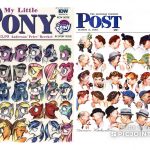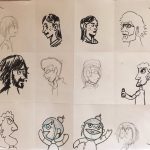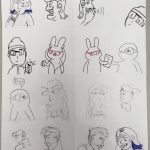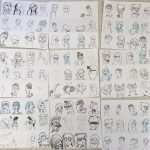This is the page for my Making Comics course Fall 2018. All my syllabi and class breakdowns are available at the Education part of my site here.
Download the syllabus in full here Making Comics Syllabus F18 VisText
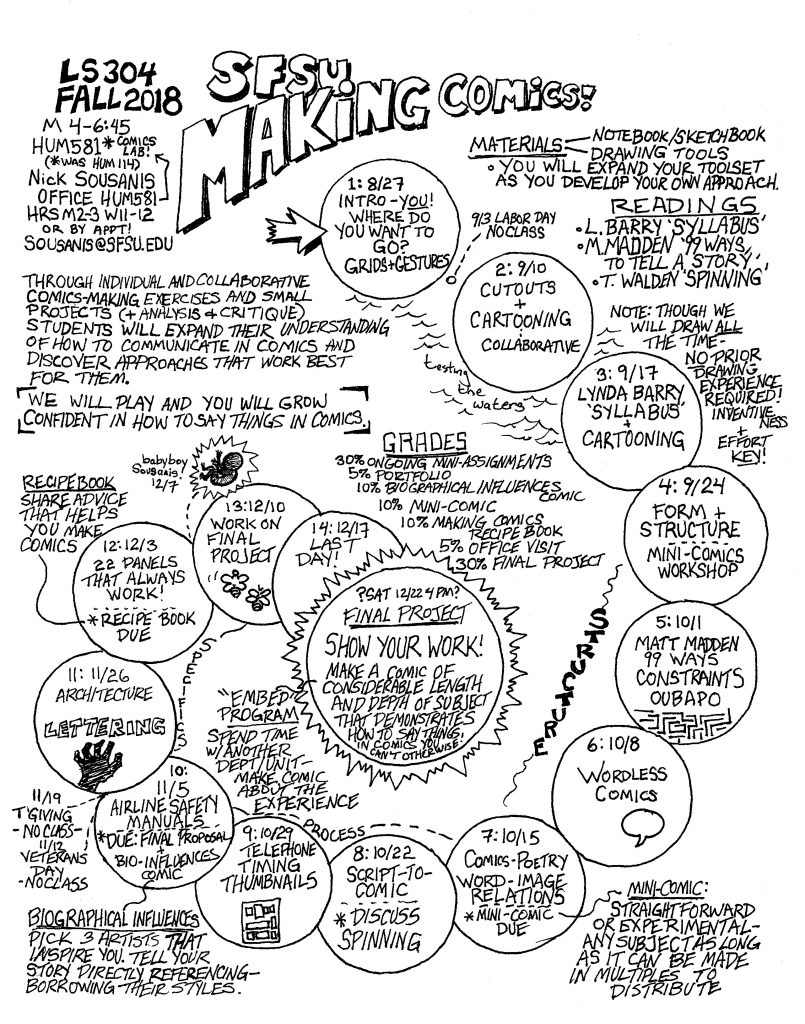
Making Comics Summary Fall 18
This is a rough breakdown of what we did each week and the various assignments and in-class exercises. The Syllabus is available here. (Examples of student work from almost all of these projects is compiled in 5 separate PDFs within this summary)
Wk1 Intro, Grids & Gestures, Intro
On this day, we laid out where we’re going, learned about each other, discussed the importance of thinking through drawing and that comics were a form available to anyone to work in, and then I had them do Grids & Gestures in class. (info here http://spinweaveandcut.com/grids-gestures/)
Response Gallery (RG) 1: [these are online spaces where students post their in-class exercises and homework projects – with scans of the work and often some brief words about the process. Often the RG will appear the week after we actually talk about it, as that’s when we share what they did.] write a brief reflection of what your interest in in comics/what brought you to this class; then list three favorite comics authors (and maybe what comics you’re reading now if any); next – say a few words about what you hope to get from this course; finally – say a bit about your experience (if any) making comics and drawing. If you’re feeling ambitious, I’d like you to post a sample or two of something you’ve made along these lines and from one of your favorite authors.
RG2: Grids & Gestures post your grids & gestures non-representational comic from Monday’s class and write a brief reflection about what’s going on in your comic and any other thoughts that you have on making it.
Wk2: Cutouts & Cartoons
In which we reflect on Grids & Gestures, play with cutouts, and think about cartoons (which we did more of the following week)… We build on what they learned from doing G&G – this means how much they already know about drawing (jagged edges hurt, smooth curves feel good, and so on), how much they learned about time and space in doing the exercise, and went from that to looking at drawing with such things as Molly Bang’s Picture This, Crockett Johnson’s Harold and the Purple Crayon, Paul Klee’s Pedagogical Sketchbook, Serge Bloch’s The Big Adventure of a Little Line, Lakoff and Johnson’s Metaphors We Live By, some book called Unflattening, and more. We then segued to working in cutouts with construction paper, and also looked at Norton Juster’s The Dot & The Line animated by Chuck Jones, Heider & Simmel Experimental Study of Apparent Behavior . Then we made relationship cutouts (see RG5) and cutout comics RG6.
RG3: Grids & Gestures as Diary: post all three of your grids & gestures non-representational comics that you do over the next two weeks and write a brief reflection about what’s going on in your comic and any other thoughts that you have on making it.
RG4: Architectural Grid to Comics page find some architectural feature (building, dresser, whatever) – take a picture of it, and then make a comics page based on the structure you found and document both. Observe some architectural composition in your world – a building, windows, a street layout, floor tilings, the dashboard of a car, whatever – find one you are inspired by, take a picture of it, then make a single comics page based on the composition of the actual architecture. Post both the image of the architectural element and your comic here.
Student EXAMPLES Making Comics F18 Summary Pt1 (PDF)
Wk3: Lynda Barry & Cartoons
This class we talked about Lynda Barry’s work, looking at examples from Syllabus (which they all read)and Picture This, and then drew connections between our work with lines and cutouts to how cartoons work. This includes looking at images of faces everywhere (i.e. electric sockets), Töpffer via EH Gombrich “illusion of life which can do without any illusion of reality: lack of elaboration guarantees the absence of contradictory clues. – perform a kind of closure”, McCloud on the power of cartoons, why Peppa Pig works, and Ivan Brunetti’s “eyebrow” expressive drawing exercise, as well as several of Barry’s exercises, like Batman in shorter timed intervals and more. They were left to spend time with Syllabus and pick out some favorite projects from it to do and share back the next class.
Lynda Barry’s Teaching Tumblr (http://thenearsightedmonkey.tumblr.com); @ the Wisconsin Institute for Discovery & Lynda’s author page at Drawn & Quarterly
RG5: Relationship Cutouts: Relationship cutout: Using cutout shapes as you choose – present a relationship that is of some significance to you through the shapes, color, and relationships you’ve arranged with the different elements… Post your relationship cutout from class here – along with a brief description of what you did and what choices you made…
RG6: Cutout Comics: Post your one-page cutout comic from class here – along with a brief description of what you did and what choices you made…
RG7: How You Got Here X2: tell the story of how you got here – this class (Interpreted however you feel like…) in a 3 Panel strip and then again in a 2 page comic (divided into as many panels as you wish). Post up here with any comments about the process you wish…
Wk4: Form & Structure + Mini-comics
Discussed Affordances of Comics – concerning structural composition, from McCloud and Eisner’s characterization of comics as sequential art, to looking at how time occurs in space in comics, to the notion of simultaneity, which is prominent in my thinking on comics and draws on Thierry Groensteen and others. Talked about the power of flat surfaces, how comics are drawing and meta-drawing (the composition), how flat surfaces allow all sorts of spatial adjacencies – comics are thus an act of drawing and meta-drawing (considering the whole page) at the same time – thus you can do weird things that can only happen in comics. We looked at weird ways comics do things, lots of examples of panel breaking of different sorts, and mentioned comics’ “flippability” as coined by Kent Worcester. Specific readings include: Richard McGuire’s original 6-page version of Here: A short rather bland comic, but one of the most influential in comics history for its demonstration of what comics could do and Moore & Veitch How Things Work Out: Fascinating use of the comics page to manipulate time… These were prompts for later exercise RG10.
Additionally we did a mini-comics making workshop – looking at instructions for straight-forward methods of making them as well as examples of unusual formats.
Mini-comics resources on my website – scroll down http://spinweaveandcut.com/making-tools-and-minicomics/ – PLEASE explore!!
From my listing – some key straightforward guides:
Abel & Madden template/instructions
Jessica Abel’s extensive mini-comic making guide
RG8: Partner-Share Comic: (As we did in class) Share a brief vignette/story of something that happened to you with your partner. Each person then makes a comic representing their partner’s story and their own story – so TWO comics in total created by each person. Post each story here labeled as to who you’re working with.
RG9: Lynda Barry Stuff: Try at least two things from Lynda Barry’s “Syllabus” in your sketchbook and post here with any reflective comments on why you chose that, what you appreciated about it, whatever…
Student EXAMPLES Making Comics F18 Summary Pt2 (PDF)
Wk5: Matt Madden Day
We started with a little continuation of form and comics, and brief looks at connections between architecture and comics. We also discussed this: Typically: Comics ~ Prose & Illustration, But perhaps, better to say (as the Canadian cartoonist Seth suggests) Comics = Poetry + Graphic Design.” And then we got to the main course for the day, to discuss the use of constraints in comics, and specifically Matt Madden’s 99 Ways to Tell a Story and try some constraint-based exercises he’s invented.
Matt Madden’s blogpost on Tic Tac Toe Jam Comics making game; Matt Madden’s list of other comics-making constraint games; Matt’s 20-Lines drawings; Oubapo site
Also: Paul Kirchner’s The Bus comic with intro and here
RG10: Formal Use of Time & Space For this exercise, create a short comic that makes use of the spatial nature of comics to do something unusual in the storytelling that could ONLY be done in comics. We’ve talked about the idea of simultaneity in comics, looked at examples of panel breaking and the role the very structure of the panels can have in the storytelling, as well as the strange play with time in Here and How Things Work Out. Play around with it, have fun with it and see what you come up with!
RG11: 3-Person Collaborative Comic first person draws a blank page composition/panel layout, the second person adds the words and word supports ( balloons, thought bubbles, caption boxes, sound effects, …) – and third person took it home to draw whatever is going on in your comic. (I have done this with the drawing being second – it is for reasons I can speculate on, not as successful.)
Wk6: Wordless Comics
We looked at wordless comics from old woodcut wordless novels to modern comics employing wordlessness in a range of ways. Some specific comics we looked at include Peter Kuper’s The System, Erik Drooker’s Flood, Shaun Tan’s The Arrival, Sara Varon’s Robot Dreams, and even not quite wordless books like David Small’s Stitches, to see how limiting words could be used to great effect. Also looked at some of David Berona’s scholarship on wordless comics.
READ: Laura Sneddon on Wordless Comics (w/great examples); David Berona on Peter Kuper’s The System article ; Giacomo Patri “White Collar” at SFSU
RG12: 99 Ways to Tell a Story +1 After exploring Matt Madden’s 99 Ways to Tell a Story, pretend that you are adding one more page to it. Take his original concept page – the base one – and make your own variation in a way that he didn’t already do in the book. Post here with any comments you might have.
RG13: 3 Ways to Tell a Story Playing off of Matt Madden’s 99 Ways book, make a one page comic of your own run of the mill story. Then, do THREE more versions of it (for FOUR in total), 1) where you play with STYLE 2) play with STORYTELLING (sequence, structure, etc.), and 3) distort FORM (things that may no longer even be comics by our definition). Push yourself to be inventive and really question the very structure of conveying a narrative. Excited to see what you all come up with! Post here and explain your constraints briefly.
Student Matt Madden Responses (PDF)
Student EXAMPLES Making Comics F18 Summary Pt3 (PDF)
Wk7: Word-Image Comics-Poetry
In which we discussed word-picture relations in comics to start – drawing on Moore, McCloud, Eisner, and tons of examples on how words are used in comics as narrative to the visual of balloons and sound effects. Then we turned to discuss comics-poetry – what it is and looked at many examples from comics and outside (things like blackout poetry and Calligrams. I had them check out the comics-poetry anthology inkbrick and read the links and short comics below…
Check out and please READ Alexander Rothman’s interview “What is Comics Poetry“.
Also, Julian Peters comics adaptation of The Love Song of Eliot’s J. Alfred Prufrock
On word-image interaction:
The Rabbit” page, with Key, On the genesis of my “Rose” page; A bit about the evolution of my own process.
READ: Alan Moore & Melinda Gebbie This is Information; Dan Clowes Mr. Wonderful
RG14: Wordless Create a short wordless comic (1-3 pages) that plays with some of the ideas we looked at in last class in discussion and in the various wordless comics we explored. Think about what you substitute for dialogue, think of ways to use text or invented text, how to give enough clues to create clarity while remaining wordless – and so, available to someone not speaking your language. Let’s make it wordless, but not silent – that is people are talking, etc… Check out the articles I posted for last week, specifically this one on Berona’s analysis of Peter Kuper’s The System. He offers 5 ways that authors do things in wordless comics that i’d like you to think about and try to incorporate into yours. Make your comic and post here with a few words about some of the things you tried (either outlined in the article or your own invention)
RG15: Comics Poetry: post a scan of your mini-comic project (and any comments you wish to share). Bring hard copies of your mini-comic to class with the intention of giving one to everyone in class. (If you made a particularly complex mini-comic such that that is not so simple, it’s ok if you only bring a few…) Looking forward!
Wk8: Spinning/script-to-comics process
We read Tillie Walden’s Spinning and discussed in class (they had done visual analysis/annotations to prep for it). The second half of class, we look at how comics scripts are translated into finished pages. (We are moving into the more technical part of the semester now…) This involved me giving them the script to a page from a Sandman script written by Neil Gaiman and a page from the Killing Joke (Batman) written by Alan Moore and then comparing what they came up with the actual published pages. I also set up the Visual Metaphor comic project RG19.
RG16: Odd Collaborative Comic So, in Step One, someone wrote a list of 10 words/phrases. In Step Two, the next person drew something that represented each word from Step One. For this final Step, make a comic using all the images you received from Step Two – you will not have access to the original 10 words. This will be a short comic, 1-2 pages, making use in some way of all the images and the comic should have words and pictures. We’ll see what comes of this…
RG16: Poetry Comic Try your hand at a short piece of comics poetry as observed in class and on www.inkbrick.com. You may invent your own comics poem, or adapt an existing poem or song, but we want to stress that you push away from doing a straight representational piece and really think about the use of the form and the specific interaction of words and pictures to get your meaning/feeling across. Looking forward to what you come up with!
RG17: Analyze page from Spinning: Pick a page you like from Spinning – and quickly redraw it and diagram all over it – how it works, how she makes meaning – notice all the cool stuff about it and POST here to prompt discussion.
Wk9: Telephone-Timing-Thumbnails
We played more telephone games with scripts to thumbnails, and looked closely at how artists create thumbnails. Also, explored timing – specifically how artists use their lower right corner before a page turn to generate interest – and then created an assignment where we worked backward from pacing choices. First thing we did was do a 3 page fight scene with back and forth between protagonist and villain, cliffhangers bottom right and some resolution by last page. Did same thing for a conversation with similar kinds of ups/downs, highs/lows.
RG18: Script-to-Page Translations: Post up your two script-to-page translations that we did in class…..
RG19: Visual Metaphor Comic In class we looked at how comics scripts become comics pages – textual description translated into visual depiction. For this assignment, I want you to try a piece where words and images co-generate one another. First, have a look at “This is Information” by Moore and Gebbie that we read a while back and I’ve posted on iLearn again. Then look at the following comics or pages by me: Show of Hands; The Rabbit Page: Maxine Says; Seeing Red/Feeling Blue; and the Rose page from Unflattening.
You are to make a one page multi-panel comic where you select a single thematic element (along the lines of what I’ve done in the examples) to use literally/metaphorically throughout as a way of linking the piece together. A short way to think about is to talk about one thing in terms of another (i.e. talk about games by talking about rabbits, talk about democracy by talking about hands, comics as roses, etc.) Keep your metaphor running in some way for each beat of your narrative. Take this in whatever direction you need to – and have fun with it!
Student EXAMPLES Making Comics F18 Summary Pt4 (PDF)
Wk10: Lettering, Architecture (Ware), & Zithers! (was supposed to be Airline Safety Manuals but skipped that this year)
Quick review of word-picture interaction, SFX, and balloons, and then looked specifically at lettering drawing on Abel & Madden, Kevin Huizenga’s class books, McCloud, and guidelines and tips from professional letters – plus thought about title lettering including of course Eisner’s Spirit title pages.
We then talked briefly on comics and architecture before me distributing pieces from Chris Ware’s Building Stories around the room for analysis and discussion. We closed with an in-class “Zithers” exercise – where I draw a directed squiggle of some sort – and then they have to layout a page that follows the reading path of that squiggle – using page composition, characters, word balloons, whatever – to move the reader’s eye in the way I randomly drew.
To help prep you for the autobiographical influences, have a look at these examples: READ (or at least skim): my comic “bi(bli)ography“; R Sikoryak’s iTunes Terms & Conditions adaptation ; pages from Sikoryak’s Terms & Conditions; my comic “A Life in Comics”
RG21: Comics Page to Script back to Page collaboration In class, we took a comics page, made a script, and someone else made a comics page from the script. Post the 3 steps here…
RG22: Thumbnail, pacing: In class, we worked on thumbnails and pacing. Post some instances from our work together here…
Wk10.5 No School (Thanksgiving)
RG23: Autobiographical Influences Comic: Make a short comic about yourself by using at least three instances where you directly reference the style from 3 different artists (comics or related) that you admire or were influenced by as a way to tell your narrative. Play with it, see if it gives you any ideas about your own drawing process, your style, composition ideas. It’s a chance to learn a bit about your own comics making by adopting the look of others. See my example “bi(bli)ography” and R.Sikoryak’s “iTunes Terms & Conditions” adaptation – all of which i linked to above… Have fun with it!
RG24: Zithers: our in-class “Zithers” exercise. Post the two examples we did in class…
RG25: Final Project Proposal: Post a short description (100-150 words) of what you plan to do for your final project, including form, length, subject matter, any other specifics about the work, and feel free to post any images if necessary to help explain what you have in mind and its feasibility so I can give you feedback.
Wk11: 22 Panels That Always Work + Hands
An exploration of “Wally Wood’s 22 Panels that Always Work” – we look at many versions of this by Wood and other artists, make our own, and then turn it into a game where I randomly draw 7 numbers from a hat, and they draw those panels as a collaboration.
We also spent a little bit of time looking at unusual panel compositions include Fred’s Philemonon. And then we looked at ways that cartoonists draw hands – from Kirby and Ditko to Adventure Time and many more, and talked about ways to develop our own shortand (ha) for drawing hands. We ended that with a collaborative exercise where they had to make a hand central to the panel they drew and then passed it on to the next person to create a full page collaboratively.
Plus, we’ll look at hands, and continue our thumbnail, layout explorations…
RG26: Your 22 Panels that Always work: Post your version of Wally Wood’s 22 Panels that always work…
RG27: Collaborative 22 Panels: In-class we did a collaborative exercise where I randomly assigned panels 9, 16, 17, 19, 4, 5, and 3.
- This is from an earlier class
- F18
- Earlier class compiled for my bulletin board!
Wk12: Recipe Book Sharing, Faces, more…
They shared their Making Comics Recipe Book Projects, then we talked about Flow. Looking at McCloud (in Making Comics) and did an exercise based on his “Hungry Lion” example. What panels do you need to tell your story? What angles make the most sense? We did a second exercise based on Abel & Madden’s “60 Panels That Just Might Work” – where they had to come up with ten ways each to compose a particular scene. Finally, we did a collaborative activity based on Norman Rockwell’s “gossip” telephone cover – where we divided a page into a grid, first person drew a self-portrait in first panel looking to left. Second person drew the next two panels – the first drawing themselves responding to the initial panel, the second drawing themselves again passing on to the right, and then the next person did the same and so on, till we got to last panel where it was given to the person who’d started that page to draw themselves in the final position. It’s always a blast!
RG28: Making Comics Recipe Book (10%):Imagine that as a group we are creating our own Making Comics Textbook, for which each class member contributes a short, single chapter highlighting some element of comics creation that you feel is particularly important, is unique to your own way of working, was helpful to you in learning to make comics – something that stands out and you’d like to explore a bit in depth in terms of organizing it in such a way to benefit others from your experience. This can include visual examples, process artifacts, the sorts of things you would want to see to learn for yourself. We’ll discuss the form and specifics together over the term, but in addition to book-like formats, we can try other formats – doing it as a video, in comics form, and something online – that provides links to related resources.
Student EXAMPLES Making Comics F18 Summary Pt5 (PDF)
Wk13: Flow/Moments continued…
This is mostly a chance to catchup on things for the final, but we do one collaborative exercise where we read together a chapter from Winnie the Pooh and they work in teams on white boards to layout how they want to tell the story (this is the insane chapter where Tigger and Piglet scheme to kidnap Roo). Then they flesh it out together and do their individual parts.
RG29: Winnie the Pooh collaborative comic: POST your finished Winnie the Pooh collaborative comics here. Try to label them in some way that makes it clear which group you are in and the sequence…
Wk14: Finale!
We share our final projects and portfolios, and eat pizza!
RG30: Final Project
RG31: Final Portfolio
Complete Collection of exercises – Note, I know things are not all here – Final Projects, some of the in-class exercises – but this should offer a big look at almost all that we did over the term…
Student EXAMPLES Making Comics F18 Summary Pt1 (PDF)
Student EXAMPLES Making Comics F18 Summary Pt2 (PDF)
Student Matt Madden Responses (PDF)
Student EXAMPLES Making Comics F18 Summary Pt3 (PDF)
Student EXAMPLES Making Comics F18 Summary Pt4 (PDF)
Student EXAMPLES Making Comics F18 Summary Pt5 (PDF)


